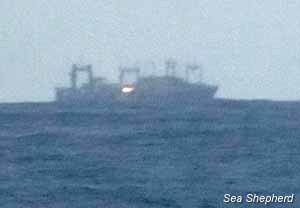The Japanese whaling fleet is facing a second year of poor whaling in the southern ocean whale sanctuary due to the dogged perseverance and tactics of two Sea Shepherd vessels: the Steve Irwin and Bob Baker. A third sea sheperd vessel, the Brigitte Bardot, was forced to retire early in the whaling season when it sustained damage from a rogue wave.
Related: Japanese Whalers Lose Bid To Block U.S.-Based 'Sea Shepherd' Activists | Sea Shepherd - ICR’s injunction is denied in U.S. District Court
From an early encounter on Christmas day onwards the Japanese fleet have been forced to deploy one and sometimes two harpoon ships and a designated security ship, the Shonnan Maru, almost permanently to following the two Sea Shepherd vessels, radioing positions to the whaling factory ship so that it can avoid a confrontation. But with the factory ship mostly on the move and with only one or occasionally two harpoon vessels to hunt whales, the number of whales caught and slaughtered is likely to be few for the season, well under the quota of 1000 whales which is set at the start of each season.
While the Japanese fleet have a resupply ship that they rendezvous with to restock fuel supplies, Sea Shepherd are forced back to port to resupply their vessels. In mid February the Bob Barker sailed to Wellington to refuel with the Shonnan Maru as a tail.
It was announced on the Sea Shepherd website the Bob Barker would rendezvous with the Steve Irwin at Macquarie Island to transfer fuel and fresh food to the other ship. The Japanese positioned vessels on either side of the island at the 12km territorial limit, and sometimes within this territorial limit. Sea Shepherd then announced the transfer would take place near Auckland Island.
By the end of February the ruse to decoy and delay the two whaling ships was made known. While Steve Irwin never intended to refuel, and the Bob Barker had sailed south to interceopt the Nisshin Maru whaling factory ship.
“We have placed the Japanese security ship, the Shonan Maru No. 2, and the harpoon vessel, the Yushin Maru No. 3, a great distance from the whaling operations and the factory ship Nisshin Maru. It could take them more than a week to return. It was a very successful ploy that has allowed the Bob Barker to be free of its tail and to knock out two of the Japanese ships from the game for more than two weeks,” said Captain Paul Watson.
“The Japanese ships fell for the bait, following hard on our heels first to Macquarie Island and then onto Auckland Island. They have wasted tons of fuel and weeks of time to accomplish nothing more than to escort the Steve Irwin back north. Now they have no one to follow anymore and the Bob Barker is free to continue the chase,” said Captain Watson.
The whaling season usually ends in mid to late march as winter weather and blizzards become more frequent. With the cat and mouse chase drawing to an end, the whalers are finding little time left for the hunt and reduced harpoon vessels able to hunt.
“Because we lost our scout vessel, the Brigitte Bardot, we have been handicapped this season. But despite that, we have chased this outlaw fleet more than 16,000 miles from west to east and from north to south. I am confident that we have severely impacted their kill quota once again.” said Paul Watson.
On March 5th the Bob Barker came within sight of the Nisshin Maru at Commonwealth Bay, sixty miles off the Antarctic Coast, inside the Australian Economic Exclusion Zone. According to the Sea Shepherd report at the time of the sighting two harpoon vessels were in pursuit of whales. All whaling activity soon stopped with the Nisshin Maru deciding to run from the Bob Barker.
“We have kept them running for two months and that has disrupted their operations considerably but now with the Bob Barker on their stern slipway, whaling is effectively shut down for 2012,” said Captain Hammarstedt (27) from Sweden.
The Bob Barker, freshly refueled, has the capacity to maintain the same speed and potentially even catch the Nisshin Maru. Although keeping the slaughterhouse ship on the run for the next 3 weeks will be sufficient in shutting down whaling operations for the rest of the season.
Paul Watson commented from the Steve Irwin one day out from Bass Strait, still with the Shonan Maru shadowing the vessel, “This has been a long and tough campaign, with the worst weather and ice conditions that we have experienced in the entire eight seasons we have ventured into the Southern Ocean Whale Sanctuary,” said Captain Paul Watson. “But despite the temporary loss of our scout ship, the Brigitte Bardot, and our constant dogged pursuit of the Nisshin Maru, we have kept them on the run, taken two of their three harpoon vessels off the hunt for two months, severely crippled their killing capabilities and now once again we have shut them down 100%. Operation Divine Wind has been enormously successful.”
Image sourced from and copyright Sea Shepherd - The Bob Barker spots the whaling fleet's factory ship The Nisshin Maru Photo: Carolina A. Castro

